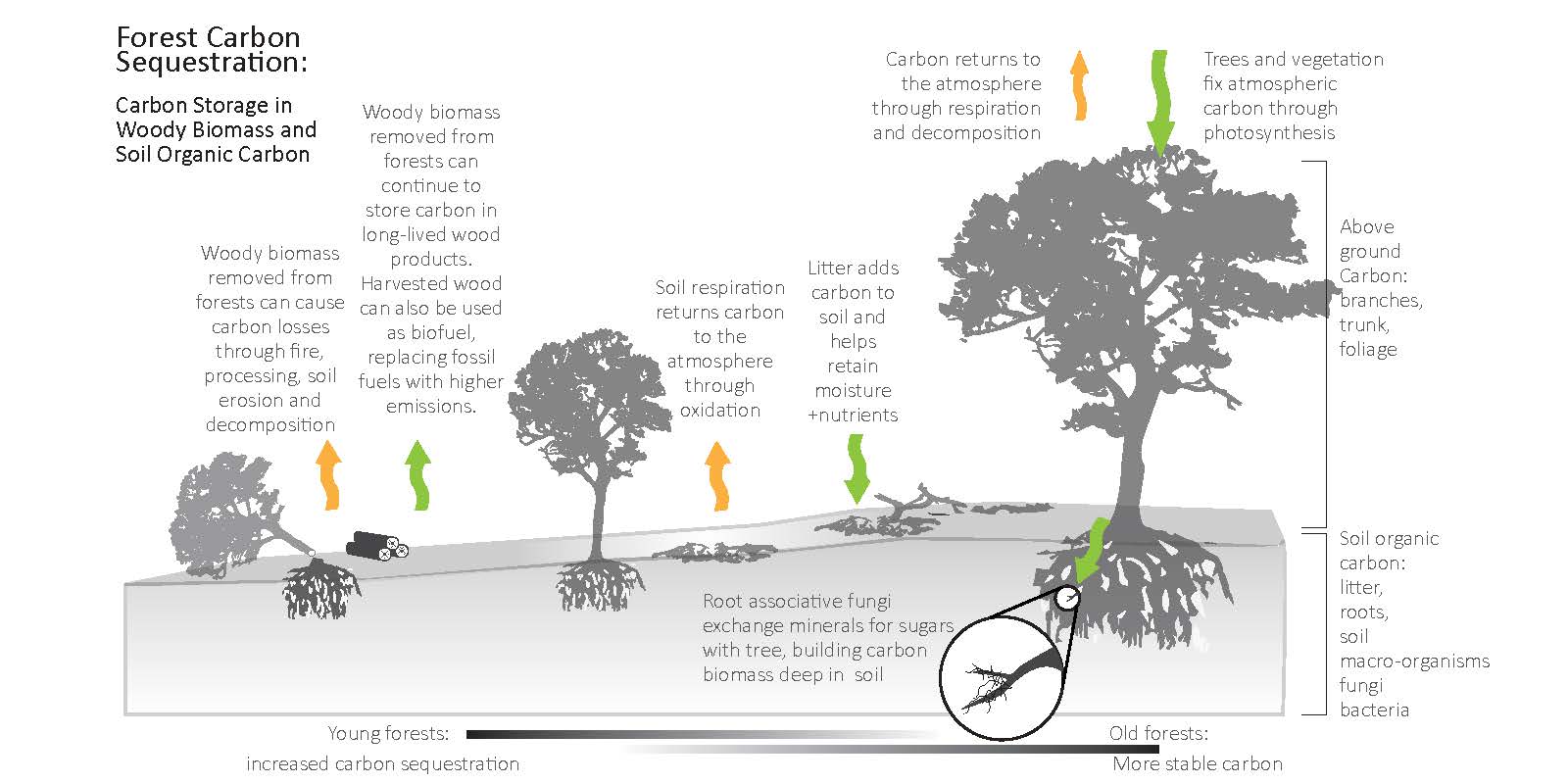Forests are well-known sinks for atmospheric carbon. In North America, the carbon content of forests (woody biomass, litter, deadwood, and soil organic carbon) is approximately 325 million metric tons. But biomass removal and other wood products use offset that amount, resulting in a net sink for North America of 217 million metric tons.1
The University of Minnesota Extension offers a helpful explanation of the terms "carbon strorage" and "carbon sequestration": "Carbon storage refers to the current amount of carbon in a tree or woodland. Carbon sequestration refers to the process by which trees and other plants use carbon dioxide and photosynthesis to store carbon as plant biomass."
The net sum of all carbon inputs and outputs from a system – like a forest, grassland, city park, or farm field – is called the "carbon balance." Inputs include woody biomass and fallen leaves, branches and soil organic matter, outputs include tree respiration and decomposition of soil organic matter and harvested biomass.The illustration shows how trees capture carbon dioxide (CO2) and sequester carbon as an effective method of reducing atmospheric concentrations of CO2.
The Carbon Cycle of Forests
Trees, like all other plants, fix atmospheric CO2 through photosynthesis and convert it to biomass and other materials necessary for metabolism. Above ground, most of forests’ long-term carbon storage occurs as woody biomass. Some of that carbon becomes soil organic carbon through addition and decomposition of fallen branches, leaf litter, and dead roots, and recent study found that 50-70 of soil carbon storage in boreal forests occurs in roots and root associated micro-organisms and fungi.2 . The remaining carbon is released back to the atmosphere from tree respiration and the decomposition of soil organic matter.
Storing carbon in woody biomass and long-lived wood products is a good choice because it is a stable, long-term carbon pool. Even if a forest is no longer sequestering additional carbon or is sequestering it at low rates, the carbon previously sequestered in biomass is preserved for a long time because wood decomposes very slowly and tree roots prevent erosion and subsequent oxidation of soil organic carbon.
Dynamic Carbon Cycling Over Time
In young trees, respiration and losses of carbon to the atmosphere are low; therefore, most of the carbon fixed through photosynthesis is converted to biomass and sequestered. As trees age, respiration increases because energy is needed to replace dying tissues and a lower proportion of carbon fixed through photosynthesis is converted to biomass and sequestered.
At a certain point in time trees no longer sequester additional carbon but instead "store" a constant quantity of carbon. This steady state condition occurs when the carbon gained from photosynthesis and the carbon lost from respiration is equal. Different tree species reach steady state at different times, somewhere between 90 and 120 years.2,3 Research indicates that late successional forests have more stable steady-state carbon pools because of a larger biomass of root associative fungi below the zone of decomposing fungi found in the oxygen rich upper soil layers.1, 2, 3
Methods to Sequester and Store Carbon
- Afforestation is the planting of trees where trees have not grown (in the last 100 years). A common type of afforestation is the planting of short rotation woody crops like hybrid poplar. These species grow very quickly and as a result sequester large amounts of carbon in a short time. They are planted and harvested within a short time frame - 10 to 15 years - and the biomass is sold for paper and other processed wood products.1
- Reforestation is the reestablishment of trees on land that had been deforested in the last 100 years.1
- Forest Management: forests can be managed to maximize their carbon storage. Lengthening time between harvests, selective thinning for increased stocking, and planting fast-growing species are techniques used to enhance carbon sequestration.4
- Long-term forest health practices that avoid whole tree harvesting and leave reserve trees to promote diverse soil ecology are most likely to promote maximum carbon storage.4
- Storage in long-lived wood products such as building materials. Harvested wood can also be used as biofuel, replacing fossil fuels with higher emissions.
Threats to Carbon Sequestration
Deforestation is caused by complete harvest of a forested area, or by prolonged degradation that leads to the destruction of a forest. About 25% of all anthropogenic (human-caused) CO2 emissions are due to deforestation. Avoiding deforestation altogether maintains the carbon stores in tree biomass and reduces soil organic carbon losses from soil respiration as a result of soil disturbance. Increased hazards to forest systems due to climate change such as drought, wildfire and insect related mortality, may make forests less stable carbon storage than they have been in the past.1
1. USGCRP. Second State of the Carbon Cycle Report. (2018). Available at: https://carbon2018.globalchange.gov/ (Accessed: 21st June 2019)
2. Treseder, K. K. & Holden, S. R. Fungal Carbon Sequestration. Science 339, 1528–1529 (2013).
3. Bradford, J. B. & Kastendick, D. N. Age-related patterns of forest complexity and carbon storage in pine and aspen–birch ecosystems of northern Minnesota, USA. Can. J. For. Res. 40, 401–409 (2010).
4. Cardenas, E. et al. Forest harvesting reduces the soil metagenomic potential for biomass decomposition. ISME J 9, 2465–2476 (2015).

